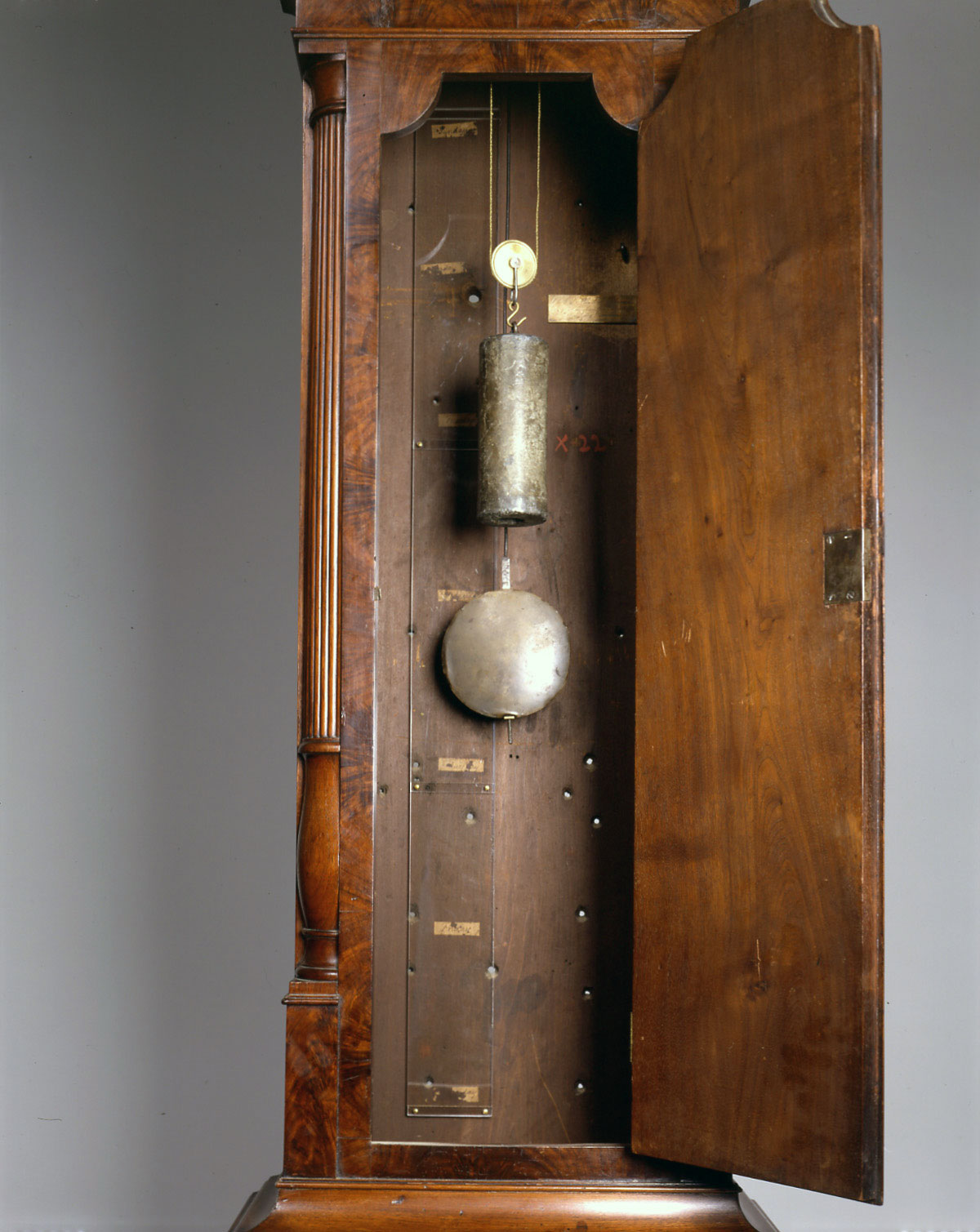Astronomical Clock
Jefferson's quest for a clock sufficiently precise to make astronomical calculations dates to his observation of a lunar eclipse in 1778, prompting him to order a timepiece from scientist and inventor David Rittenhouse, but the project was abandoned during the Revolutionary War. Over thirty years later, Jefferson asked his friend Robert Patterson, director of the U.S. Mint in Philadelphia for ideas on acquiring an astronomical clock: [1]
Patterson recommended "ingenious artist" Thomas Voight (also spelled "Voigt"), son of clockmaker, watchmaker, engineer, and coiner of the U.S. Mint, Henry Voight, a man well known to Jefferson who would make a clock for sixty-five dollars.[3]
Jefferson commissioned the younger Voight to make a clock "as good as hands can make it, in every thing useful; but no unnecessary labour to be spent on mere ornament. a plain, but neat mahogany case will be preferred."[4] Voight completed the timepiece a year later, but the War of 1812 delayed its shipment to Monticello until December 1815.[5]
The clock's final price of $155.50 was almost twice Voight's estimate. Elaborately decorated, the clock's dial and case are a panoply of ornamentation Jefferson expressly did not desire.
Situated in his private suite, the clock has no striking mechanism and operates with a single weight with day marking labels affixed in Jefferson's handwriting on the inside of the clock case corresponding to the position of the descending weight.
After Jefferson's death, his granddaughter Ellen Coolidge wanted to purchase the clock as a memento of the objects Jefferson "habitually used in his chamber."[6] but Jefferson's daughter Martha chose to gift the clock to Doctor Robley Dunglison, Jefferson's physician at the time of his death. [7] Jefferson had recruited Dunglison, who was born and educated in England, to be professor of medicine at the University of Virginia.
At the sale of Jefferson's estate in 1827, three people bid on the clock: Dr. Dunglison, Nicholas Trist, husband of Jefferson's granddaughter, Virginia, and Jefferson's friend General John Hartwell Cocke. Trist, acting in Martha Jefferson Randolph's behalf, outbid Dunglison and Cocke (who then purchased another clock). Dunglison noted the bidding in his diary:
"I had no knowledge of the intention of Mrs. Randolph to bestow this clock on me; but had determined to possess it, if it went at a reasonable rate, at the sale. ... General Cocke, of Fluvanna, bade, I think, 145 dollars. I bade 150; and it was knocked down to Mr. Trist for one hundred and fifty-five dollars. I immediately went up to Mr. Trist, apologizing for having opposed unwittingly the desire of the family to possess the clock, when he told me I might make my mind easy, as he had been commissioned by them to buy it, in order that they might present it to me."[8]
Dunglison left the University of Virginia in 1833 to become Chairman of the University of Maryland Medical School before settling in Philadelphia in 1835 as Chairman of Jefferson School of Medicine. The clock remained in Dunglison's family and was bequeathed to the Historical Society of Pennsylvania from the estate of his son, William Ladam Dunglison, in 1894. The Thomas Jefferson Foundation acquired the clock in 1999, returning it to Jefferson's suite where it stands today.
-Based on The Worlds of Thomas Jefferson at Monticello by Susan R. Stein, updated and amended by David Thorson, 6/24
Further Sources
- Monticello Curatorial Database: Astronomical Case Clock.
- King, Henry C., and John R. Millburn. Geared to the Stars: The Evolution of Planetariums, Orreries, and Astronomical Clocks. Toronto: University of Toronto Press, 1978.
References
- ^ Silvio A. Bedini, Thomas Jefferson: Statesman of Science (New York: Macmillan, 1990), 420-21.
- ^ Jefferson to Patterson, September 11, 1811, in PTJ:RS, 4:149. Transcription available at Founders Online.
- ^ Patterson to Jefferson, November 11, 1811, in PTJ:RS, 4:230. Transcription available at Founders Online.
- ^ Jefferson to Patterson, November 10, 1811, in PTJ:RS, 4:229. Transcription available at Founders Online.
- ^ Jefferson, December 27, 1815, in MB, 2:1317. Transcription available at Founders Online.
- ^ Joseph Coolidge to Nicholas P. Trist, January 5, 1827, Nicholas Philip Trist Papers, 1795-1873, Library of Congress. Transcription available in Jefferson Quotes and Family Letters.
- ^ Martha Jefferson Randolph to Septimia A. Randolph, February 5, 1827, Septimia Anne Cary Randolph Meikleham Papers, 1825-1884, Accession #15410, Special Collections, University of Virginia Library.
- ^ Samuel Radbill, ed., "The Autobiographical Ana of Robley Dunglison, M.D.," Transactions of the American Philosophical Society 53 (1963): 34.


